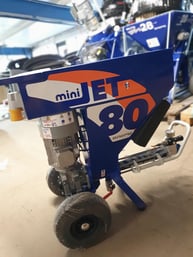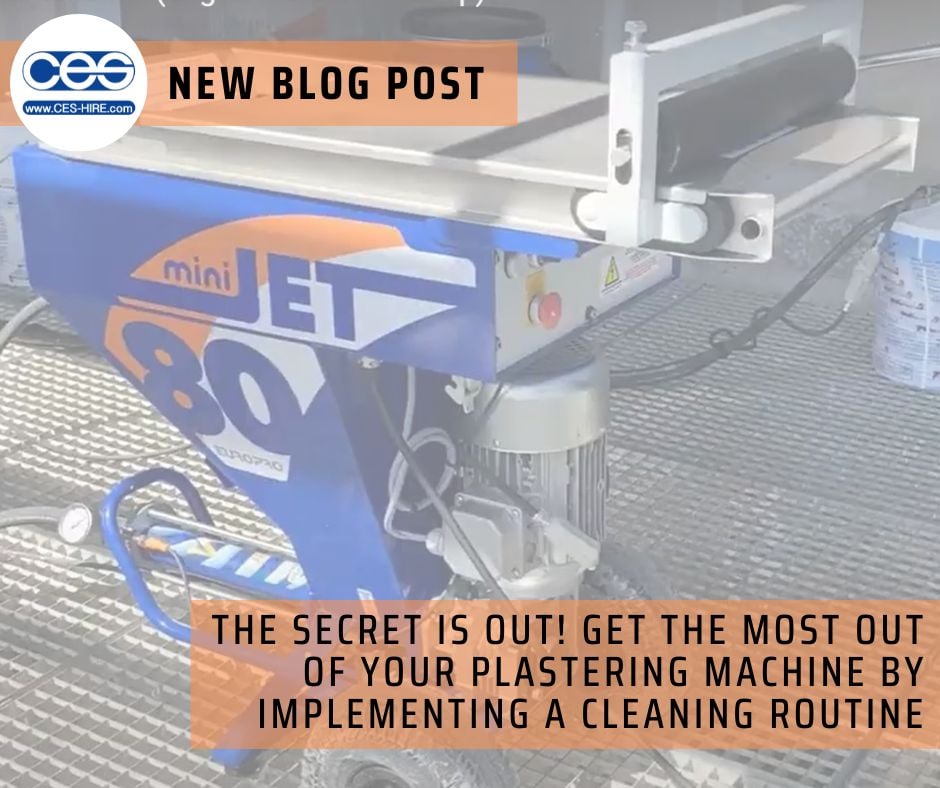Plastering, Machine Maintenance
The Secret Is Out! Get The Most Out Of Your Plastering Machine By Implementing a Cleaning Routine
Plastering Machines like the Euromair Minijet 80 or Minijet 120 will pay you back on your investment multiple times over. With benefits such as reduced manual labour, increased plastering speed, improved plaster consistency, less room for human error and greater uniformity across larger jobs, a plastering machine is a great option to investigate. For more information about how a plastering machine works, head here > To keep these machines working at optimum level, it’s vital to carry out regular machine maintenance and importantly, clean your machine properly. Follow our tips below for a happy and healthy machine.
Squeaky Clean
It may seem obvious, but simply keeping up with a good thorough cleaning routine after each use will work wonders. A clean machine not only improves your company’s image but also keeps your machine, and in particular its wear-parts, in the best possible condition. Whilst plaster drying to a smooth, solid coating is exactly what you want on your walls, solid plaster is not ideal in your machine. Solidified plaster in hoses, around the rotor and stator or in the mixing chamber, can cause problems. Take a look at our guidance for cleaning your plastering machine.
Step-By-Step Clean
The following guidance is based on our electric Euromair Minijet 80/120 but machines will vary so always refer to the specific guidelines in your machine user manual.
 Remove the nozzle from the spray gun and place in a bucket of clean water
Remove the nozzle from the spray gun and place in a bucket of clean water- Open the spray gun to fully empty the hopper
- Open the drain valve, thoroughly clean the hopper with water and liquid soap (e.g. fairy liquid), close the drain valve once clean
- Remove the filter from it’s housing (if fitted) and clean it
- Disconnect the product hose and run machine (around speed setting 3) for around 30 seconds to clean the pump (time can vary, but ensure clear water is passing through the rotor and stator)
- Disconnect the spray gun from the product hose and place into a clean bucket of water
- Place the sponge cleaning ball inside the hose and reconnect the hose to the machine
- Run the machine again (speed setting 3) allowing the product and sponge ball to flow out
- Repeat the process with the sponge ball until the water runs out clear (we recommend putting through the ball a minimum of twice)
- Clean the spray gun and nozzle with a brush. When clean replace on the end of the hose
- Open the drain valve to empty the remaining water and then close again
- Fill the hopper with a little water combined with storage liquid (up to the level of the safety grill)
- With the spray gun open, run the machine for 1 minute to allow the storage liquid to stay in the hose
Ta-da! There you have it. A super shiny machine that looks like new and should fire up quickly and efficiently for you next time you use and will generally prolong the life of your machine. There are many other reasons why machine maintenance is crucial including health and safety, reducing long-term costs and improving the finish of your plaster; read more here >
Storage & Servicing & More
Whilst cleaning your machine properly really aids in prolonging the life of your machine, there are many other aspects of machine maintenance you should consider. Storing your machine correctly is crucial in keeping your machine working at its best. Once your machine is clean ensure it is sufficiently protected and check that there is still some water/storage fluid (fairy liquid will do the job) at the bottom of the hopper. Servicing your machines is also key in getting the most out of your machine. With a diesel machine, we would recommend getting a full service roughly every 150 hours. Electric machines are slightly different in terms of servicing and we would suggest an annual check before the spray season begins. This machine ‘health-check’ would include checking over water and air filters as well as ensuring the rotor and stator has plenty of life (pressure) left in it. Pre-use checks will also help extend the life of your machine; parts to check include:
- The rotor and stator-is there enough pressure? You’ll know when it needs replacing as the pressure and speed will drop
- Hoses and couplings-are they clean and in good condition? Worn or perished hoses can be dangerous and may split under pressure
- Is there a consistent power source so that the machine will not trip out?
For more tips on how to get the most out of your machine take a look at this blog >



